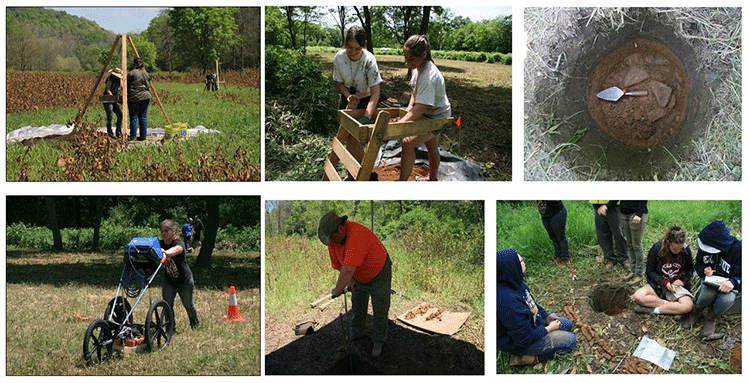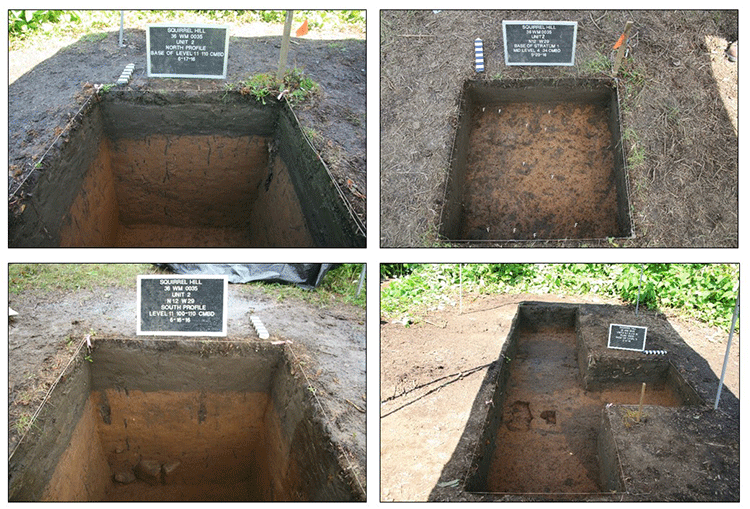The 2024 IUP Archaeological Field Schools will take place at the prehistoric Squirrel Hill Site (36Wm0035) under the supervision of Lara Homsey-Messer and William Chadwick. The site is a Johnston-phase Monongahela village (ca. 1450-1590) located along the Conemaugh River near the modern town of New Florence, Pennsylvania. Investigations will include a combination of geophysical survey, shovel testing and test excavations, and geomorphic augering.
The Squirrel Hill site has been known to archaeologists since the 1950s, but little systematic investigation of the site has taken place since then. Because it has been heavily collected by local residents for decades, the Archaeological Conservancy purchased the property in 2005 in order to protect it from further damage and minimize the loss of data. Despite being listed in the National Register of Historic Places, many research questions remain to be answered, such as 1) verifying occupation and cultural affiliations; 2) characterizing the internal arrangement of houses, plaza, and stockades; 3) contextualizing its relationship with other Johnston Phase sites in western Pennsylvania; and 4) reconstructing the paleo-landscape and environmental change through time.
 IUP archaeological investigations at the Squirrel Hill site
IUP archaeological investigations at the Squirrel Hill site
In 2016 and 2022, in partnership with the Archaeological Conservancy and the Seneca Nation of Indians, IUP Anthropology began to investigate these questions as part of our annual summer Archaeological Field School. Field school students working under the supervision of William Chadwick and Lara Homsey-Messer used a combination of traditional archaeological methods —such as shovel testing and test unit excavations—coupled with geophysical survey and geomorphic augering to address the above research questions.
The 2016 and 2022 field schools recovered pottery, lithic debitage, a lot of fire-cracked rock (likely used in cooking and possibly sweatbathing), and over 80 features (such as post molds and storage pits). Excavations indicate that occupation of the site was more complex than initially believed. Of particular interest, ground penetrating radar (GPR) identified a large rectangular structure significantly different in both size and shape from typical Monongahela domestic structures.
The results of the 2022 field season highlighted three important discoveries. First (1), the site is much larger than previously believed, making Squirrel Hill the second largest known Monongahela site in western Pennsylvania. Second (2), ground truthing of the rectangular GPR anomaly identified in 2016—a possible longhouse—confirmed that the structure is precontact and is characterized by a domestic assemblage of lithics, fire-cracked rock, and ceramics. Unfortunately, no charcoal was recovered for AMS dating, and no features were identified. Artifacts were quite small (<2cm). A Bw horizon below the plow zone (Ap) suggests that historic plowing has obliterated the former land surface, at least in the eastern side of the structure. Finally (3), AMS dates suggest that the site has multiple components: two Monongahela occupations—one conforming to the expected Late Middle Monongahela Johnston Phase (1450-1590 AD) and the other an Early Middle Monongahela Period (1250-1450 AD.)—and an ephemeral early Late Woodland occupation (ca. 400-550 AD). It is likely the site consists of several overlapping villages which grew over time.
Perhaps unsurprisingly, our first two field seasons left us with more questions than answers, but, of course, that is half the fun and challenge of archaeology. This summer’s field school will focus on clarifying the nature of the pre-Johnston Phase occupations, determining how large the site was, finding the central plaza and/or site stockade; and further ground-truthing the rectangular structure. We anticipate that many master's and undergraduate theses will be directed toward answering these questions in the years to come.
 Excavation units at Squirrel Hill. Features are clearly visible in the bottom right photo.
Excavation units at Squirrel Hill. Features are clearly visible in the bottom right photo.